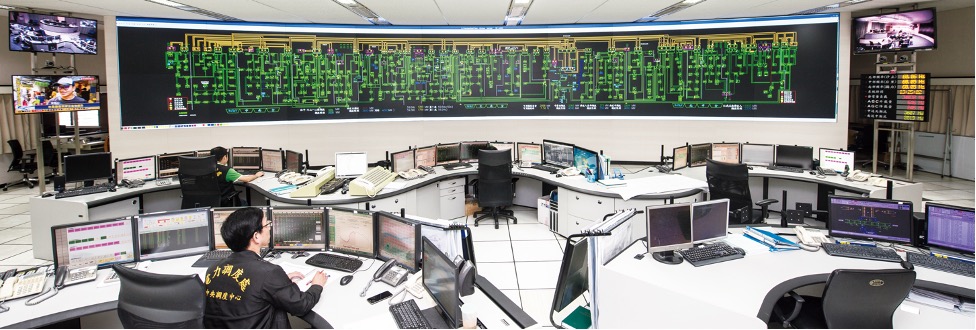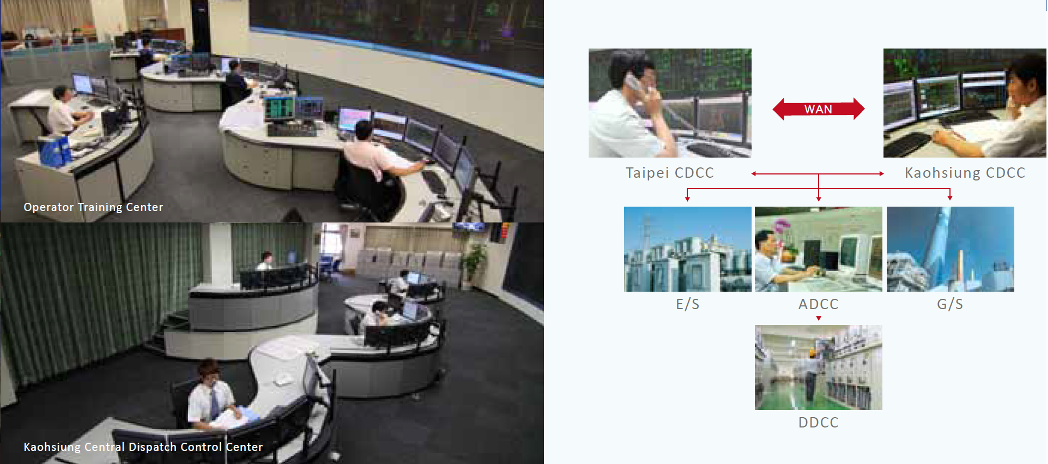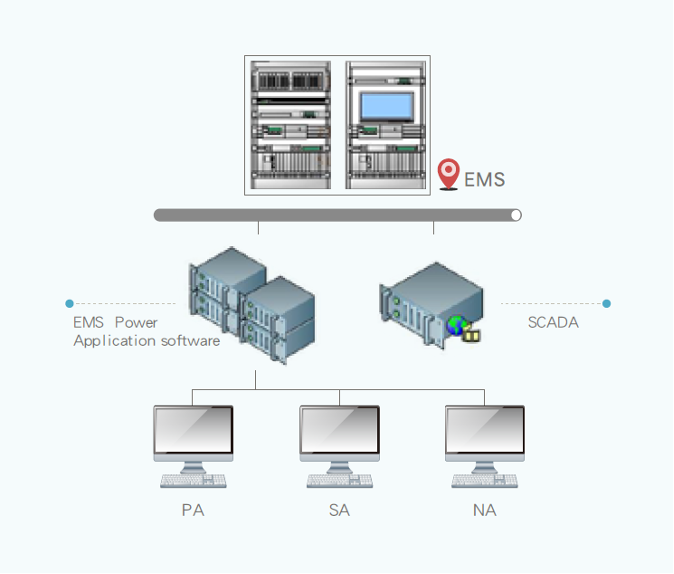Central Dispatch Control Center (CDCC), the core of TPC’s system generation dispatching and network control, is the center of the national electricity supply operations. The tasks of the CDCC are to operate the national power generation and the transmission grid of the whole country, including water resources coordination, thermal (coal, oil, and natural gas) and nuclear power plants dispatching, and the EHV substations and network control.
The operators in CDCC are on duty 24-hours a day to monitor the system operating status, meet the power demands, and maintain the stability and security of the power system.

Figure 2.1 The CDCC of TPC
Dual-Master Synchronous Operation Scheme (DMSOS)
The Energy Management System (EMS) was first installed at the CDCC of TPC in 1980 and replaced by a second-generation system in 1990. Several factors led to the deployment of a backup CDCC, including a large earthquake in 1999, the September 11th terrorist attack in the United States, SARS, and H1N1 natural disasters. Since then, TPC has updated the EMS of CDCC in Taipei (TCDCC) and deployed a full copy of the EMS and control center in Kaohsiung (KCDCC). However, with the increased need for operators and advanced multi-site functions of EMS, TPC finally decided to set up equal personnel on both sites.
In response to these events, KCDCC now plays not only the backup role but also as a peer-to-peer control center that corresponds to TCDCC. This means that in addition to the facilities matching, the operators are also identical on both sites. When one site stops functioning, the other can immediately take over all real-time tasks to ensure no disruption in system operations. This new third-generation EMS with dual control centers was completed on July 10th, 2009. After refining various functions of the new EMS and the supplement of the staff, especially operators in K -site, a Dual-Master Synchronous Operation Scheme (DMSOS) has been successfully operating in the TPC system.

Figure 2.2 The DMSOS of TPC
Hardware Configuration
With DMSOS operations, open protocols and distributed systems platform architecture is used to build a computer system that can operate in Taipei or Kaohsiung site independently. The two sites are connected to each other via three independent routes of high-bandwidth WAN, including two fiber-optic SDH (synchronous digital hierarchy) backbones (50Mx2) and one microwave channel (7xT1, 10M) to ensure the reliability of SCADA data exchange and synchronization.
The data collected from the RTU/ICCP of power plants, extra-high voltage (EHV) substation, and ADCC are sent to the two sites simultaneously, while in normal conditions just one site, named DRCC (Data Responsibility Control Center), to receive and exchange synchronously so that the operators in two sites could see the same real-time information and operate the power system either independently, or merged as a single virtual center.
Besides, based on the remote function of EMS and with a dedicated WAN, two emergency remote control centers are installed in case of operators could not enter the main control center for any reason and could dispatch the power system remotely.
Software Applications
The EMS is equipped with a complete set of the most advanced applications for power system operation planning. It consists of the supervisory control and data acquisition (SCADA), power application (PA), network application (NA), and scheduling application (SA).
Automatic generation control (AGC), the main function of PA, can be transferred to any site at any time and supports the capability to simultaneously handle multiple control areas caused by network islanding. Economic dispatch (ED) allocates the generating demands among the committed units to minimize operating costs. For NA, besides the state estimation (SE) combined with fault current calculation (FC) and contingency/security analysis (CA/SA) for steady-state vulnerability assessment. Unit commitment (UC), the main function of SA, determines the schedules for thermal generating units while minimizing the total operational cost, and satisfying system load requirements and operating constraints over the study periods. With the advanced applications and equipment, the EMS takes into account real-time system security surveillance to improve the power supply quality and reduce operating costs.
Operators not only use the EMS to dispatch the power system, in addition, Power System Facility Maintenance Management System (PMS), Phasor Measurement Units (PMU), Lightning Location Detection System (LLDS), and Quantitative Precipitation Estimation and Segregation Using Multiple Sensor (QPESUMS) are also introduced to provide the information needed for the dispatching strategic judgments.

Figure 2.3 EMS Software Applications
Innovation and Challenges
With the new advanced EMS schemes and functions implemented in CDCC, a Dual-Master Synchronous Operation Scheme (DMSOS) has been successfully operating in two-site control centers and is identical not only at the EMS facilities but also in operation staffs. Operators under DMSOS are able to monitor and control the system in a more reliable, stable, safe and efficient manner. We anticipate that the reliable service of the TPC system will be greatly enhanced and the probability of blackouts due to natural disasters and attacks could be minimized. We believe that this novel operation scheme is the first system operated in the world and will become a model for future power system control center design and operations. Power system operations in TPC are now facing many challenges, such as the implementation of the smart grid, the development of renewable energy, the capacity increase of wind power, solar energy, and natural gas units, the impact of the greenhouse issue, the measurement of compound disasters, the competition from private power plants, and the deregulation and liberalization of the power market. Nevertheless, we have confidence that these issues will be well managed in the future.